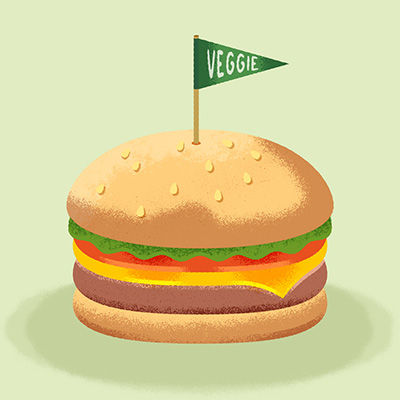NAIT alumni take up the challenge of providing an alternative to the alternative
On most days, chef Maynard Kolskog (Cooking ’82) has ample room in his research kitchen to chop, cook and refine recipes. Today, however, counter space is in short supply owing to all of the bowls, jars, bins and ingredients assembled for his latest culinary experiment.
Some of the items are recognizable to the home cook, including white button mushrooms, canola oil and beans. Others are less familiar: nutritional yeast, agar agar, oat starch, xanthan gum, konjac flour made from a southeast Asian tuber and transglutaminase, sometimes called “meat glue” because it’s used to bind proteins in processed products like chicken nuggets.
“The real challenge is getting the proper texture. It’s really, really hard.”
The scene exemplifies the kind of culinary and food science wizardry that’s required to transform food beyond base ingredients and tap into one of the hottest food trends: plant-based “meat” in the vein of Beyond Meat burgers or vegan chicken wings.
“The real challenge is getting the proper texture. It’s really, really hard,” says Kolskog.
 The certified research chef with NAIT’s Centre for Culinary Innovation is currently developing his own versions of fake chicken and beef – embracing a challenge that may prove rewarding. Once relegated to natural food stores, meat alternatives are now big business. The global market for plant-based meat is worth US$12.1 billion, and expected to more than double by 2025.
The certified research chef with NAIT’s Centre for Culinary Innovation is currently developing his own versions of fake chicken and beef – embracing a challenge that may prove rewarding. Once relegated to natural food stores, meat alternatives are now big business. The global market for plant-based meat is worth US$12.1 billion, and expected to more than double by 2025.
In Canada, just 2.3% of the population identifies as vegan, according to a recent study from Dalhousie University. However, the same study found much higher rates of vegetarianism and “flexitarianism” with 6.4 million Canadians having either eliminated or reduced their meat consumption. And almost a third of those polled had thought about cutting back on meat within the next six months.
Eschewing meat has implications for animal welfare, climate change and human health, but is chewing on highly processed, factory-made plant-based imposters a palatable alternative? That may depend on how well “meat glue” sits with you.
Meatless makes waves
The world isn’t suddenly turning its back on animal protein. In fact, meat is as popular as ever. Global production was forecast to reach 335 million tonnes last year, up 1.5% from 2017 due to growing demand in China, the European Union and the United States. Nevertheless, the market appears to be making room for alternatives.
Beyond Meat’s introduction to the North American market in 2013 is largely seen as the turning point. The company’s lineup of meatless burgers and chicken are sold in grocery store meat cases, surrounded by the real thing, in an effort to appeal not just to vegans or vegetarians but to omnivores seeking to cut back for health, environmental or other reasons.
Fake meat has even made inroads in fast food. Beyond Meat has partnered with chains such as A&W and KFC on a line of burgers, breakfast sausage and fried chicken. The manufacturer’s chief rival, Impossible, worked with Burger King to create the Impossible Whopper while fellow food industry titans Tyson Foods and Nestle have jumped onto the plant-based meat wagon with their own versions of chicken nuggets and, yes, more burgers.
Edmonton chef Levi Biddlecombe (Culinary Arts ’11) worries that placing the two products side by side in the market sends a confusing message to consumers. To him, swapping out one highly processed meat for an analog isn’t just perplexing, it’s frustrating.
“All of a sudden you take the animal products out and process it just as much – if not more – and suddenly it’s OK and it’s a healthy alternative?” he says.
“We’re just making balanced plates of food that are really good that happen to be vegan.”
The chef-owner of Why Not Café and Bar has sampled several bushels-worth of plant-based meats and vegan products over the years. His sister, Brooke, is vegan and family dinners include some kind of meatless entree.
“I’ve tried some of the worst – literally chemically altered proteins you can’t replicate in the kitchen,” he says.
 Instead, Biddlecombe focuses on maximizing flavours with fresh, simple ingredients. In fact, meatless dishes have become staples at Why Not, representing about 40% of the menu. The closest the chef gets to replicating meat is vegan charcuterie, including cured and smoked veggies and vegetable pate (along with cashew cheeses and house-made pickles).
Instead, Biddlecombe focuses on maximizing flavours with fresh, simple ingredients. In fact, meatless dishes have become staples at Why Not, representing about 40% of the menu. The closest the chef gets to replicating meat is vegan charcuterie, including cured and smoked veggies and vegetable pate (along with cashew cheeses and house-made pickles).
Biddlecombe feels his menu anticipates the plant-based trend “we knew was going to come.” Sales generated from vegan dishes and everything else are split about 50-50 – a ratio he thinks could eventually climb to 60% vegan.
“We’re just making balanced plates of food that are really good that happen to be vegan.”
A meatless burger may be a gateway to dishes like Biddlecombe’s, but you won’t find one on his menu. “We’re not trying to replicate anything because it’s never going to live up to the original anyway.”
Is plant-based healthier?
Replicating the salty-sweet-umami flavours, complex mouthfeel and textures of meat is no easy feat. Companies have poured millions into research and development of mass-produced meatless products, which rely heavily on soy, peas, rice and other proteins, coconut and canola oils and a laundry list of other ingredients.
The highly processed nature of a meat-analogue burger is sometimes lost on consumers, says NAIT registered dietitian Nick Creelman, who works with clients that automatically assume “plant-based” means, “I am eating healthy now.” That isn’t necessarily the case.
The problem with meatless products, Creelman says, is that the industry has, quite naturally, focused on developing tasty, meat-like foods that will sell, instead of trying to make the healthiest product. Beyond Meat founder Ethan Brown’s original idea was to create a more ethical fast food burger – emphasis on fast food.
Beyond Meat burgers and its cousins may not come with the risks of heart disease, stroke and diabetes often associated with meat, but they tend to come with just as many calories and are high in sodium. (An A&W Beyond Meat burger clocks in at 29 g of fat and 1,110 mg of sodium – more than one of their beef burgers.)
These meatless products are too new to make any definitive claims about their nutritional benefits versus meat; the science simply hasn’t caught up. But generally speaking, if the bulk of your veggie and plant consumption comes from a factory, you’re still not doing your body any favours, Creelman says. Such products fail to deliver a complete protein like meat or pulses and any vitamins naturally occuring in veggies have to be added again after processing strips them out. That puts Beyond Meat and its plant-based cousins in a similar category as their beefy forebears.
“They … shouldn’t be something we are looking to eat every day,” he says.
These types of foods do deliver ethically. In addition to animal welfare, plant-based meat is better for the environment (research suggests a vegan diet is the single biggest way to reduce your carbon footprint).
“People in the end are looking for more whole foods versus highly processed.”
The good news, Creelman adds, is that the food industry is starting to respond to consumer demand for healthier, more “natural” products that are still convenient. He’s already noticed an increase in meatless foods touted for having fewer or less- processed ingredients than others.
“People in the end are looking for more whole foods versus highly processed.”
 In a perfect world (or a dietitian’s version of one), more people would apply that desire to cooking with plant-based proteins such as whole grains and pulses. But Creelman recognizes that’s not a skill everyone is comfortable with.
In a perfect world (or a dietitian’s version of one), more people would apply that desire to cooking with plant-based proteins such as whole grains and pulses. But Creelman recognizes that’s not a skill everyone is comfortable with.
As Biddlecombe puts it, “We’ve forgotten how to feed ourselves.” Foods like Beyond Meat aren’t just popular because they look, smell and taste like the real thing; they’re easy, especially for those who can’t cook or lack the time. That’s a problem that affects vegans, vegetarians and meat-eaters alike.
“Nobody knows how to cook anymore,” Biddlecombe says. “If you don’t do it for a living or it’s not something you’re super passionate about or a hobby that you really enjoy, people just don’t do it.”
Creating healthier alternatives
Back in NAIT’s research kitchen, Kolskog continues to put his own passion toward striking a balance. He wants to recreate the experience of eating meat, but do it with a healthier alternative.
“I enjoy the challenge,” he says while spooning homemade barley and yellow pea miso into a mixing bowl.
Even if his products are still far from being market-ready, Kolskog thinks he’s on the right track, with a focus on healthy, local ingredients. For all the gastronomic powders he uses to simulate the mouthfeel or textures of fatty meat, his recipe is predominantly made of mushrooms and beans – northern white beans for chicken and kidney beans for beef.
He’s sourced as many homegrown products as possible, passing over rice and soy for Alberta barley, yellow peas and oat starch (the latter tying into another research project he’s working on). Fat, necessary for mouthfeel, comes from Prairie canola infused with spices like peppercorns or coriander to mimic a “Montreal-style smoked meat” profile.
“We have such great crops that are underutilized and undervalued,” he says.
Kolskog uses a combination of buckwheat flour and pea protein, meaning he can deliver a nine-amino-acid protein on par with meat, cheese or fish.
“That’s one thing that’s missing from present meat analogues – a complete protein profile,” he says.
“We have such great crops that are underutilized and undervalued.”
Once assembled, the mixture is shaped into a sausage and steamed, and can be sliced or ground without turning to mush. He’s even transformed the kidney bean version into a “beef” Wellington that he served to his family last Christmas.
Kolskog isn’t out to take on Beyond Meat, which employs an army of food scientists. But he and his tiny team see the need for an alternative to the alternative. It won’t ever appear on the menu of a place like Why Not, but it might bring more industry clients and the public around to exploring the whole foods that people like Biddlecombe and Creelman champion.
No matter how close he gets to replicating the unctuous, umami flavours and textures of meat, Kolskog says he’ll always lean toward the real thing – in moderation. That’s a personal choice, but that’s exactly what his research is all about. He wants to give consumers more choices for the supper table, their health and the planet.
“You can’t deny there’s people out there buying this stuff; they like it and they believe in it,” he says.
No matter how you grind it, slice it or dice it, belief is almost as powerful as taste. Everything else is just filler.